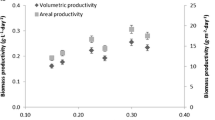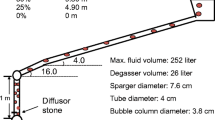Abstract
A novel reactor for outdoor production of microalgae is described. Air-lift is used for circulation of the culture in transparent tubes lying on the ground and interconnected by a manifold. Dissolved O2 is removed through a gas-separator placed 2.0 m above the tubes and water-spray is used for cooling. The manifold permits short-run durations between leaving the gas separator and re-entering it, preventing thereby damaging accumulation of dissolved oxygen. Day temperature control in summer is attained using water-spray. In winter, temperature in the tubes rises rapidly in the morning, as compared to an open raceway even if placed in a greenhouse. The number of hours along which optimal temperature prevails in the culture throughout the year increased significantly. Very high daily productivity computed on a volumetric basis (e.g. 550 mg dry wt l−1 culture) was obtained and preliminary observations indicate that a significantly higher output, e.g. 1500 mg dry wt l−1 d−1 is attainable. Much more research is required to assess the year-round, sustained productivity attainable in this reactor.
Similar content being viewed by others
References
Albertson ML, Simons DB (1964) Fluid Mechanism. In Chow VT (ed.), Handbook of Applied Hydrology. A Compendium of Water-resources Technology. McGraw-Hill Book Company, New York, 7–18.
Bennet J, Bogorad L (1973) Complementary chromatic adaptation in a filamentous blue-green alga. J. Cell Biol. 58: 419–435.
Boussiba S, Sandbank E, Shelef G, Cohen Z, Vonshak A, Ben-Amotz A, Arad S, Richmond A (1988) Outdoor cultivation of the marine microalgaIsochrysis galbana in open reactors. Aquaculture 72: 247–253.
Gudin C, Chaumont D (1983) Solar biotechnology study and development of tubular solar receptors for controlled production of photosynthetic cellular biomass. In Palz W, Pirrwitz D (eds), Proceedings of the Workshop and E.C. Contractor's Meeting in Capri. D. Reidel Publishing Company, Dordrecht, 184–193.
Gudin C, Chaumont D (1991) Cell fragility — the key problem of microalgae mass production in closed photobioreactors. Bioresource Technology 38: 145–151.
Pirt SJ, Lee YK, Walach MR, Pirt MW, Balyuzi HHM, Bazin MJ (1983) A tubular bioreactor for photosynthetic production of biomass from carbon dioxide: design and performance. J. Chem. Tech. Biotechnol. 33B: 35–58.
Richmond A (1991) Large-Scale Microalgal Culture and Applications. In: Round , Chapman (eds), Progress in Phycological Research. Biopress Ltd., Bristol, England, 1–62.
Sorokin C (1959) Tabular comparative data for the low- and high temperature strains ofChlorella. Nature (London) 184: 613.
Thomas SP, Zaritsky A, Boussiba S (1990) Ammonium excretion by an L-methionine-DL-sulfoximine-resistant mutant of the rice field cyanobacteriumAnabaena siamensis. Appl. environ. Microbiol. 56: 3499–3504.
Torzillo G, Pushparaj B, Bocci F, Balloni F, Materassi W, Florenzano G (1986) Production ofSpirulina biomass in closed photobioreactors. Biomass 11: 61–64.
Vonshak A (1986) Laboratory techniques for the culturing of microalgae. In: Richmond A (ed.), Handbook for Algal Mass Culture. CRC Press, Boca Raton, Florida, 117–146.
Author information
Authors and Affiliations
Rights and permissions
About this article
Cite this article
Richmond, A., Boussiba, S., Vonshak, A. et al. A new tubular reactor for mass production of microalgae outdoors. J Appl Phycol 5, 327–332 (1993). https://doi.org/10.1007/BF02186235
Received:
Accepted:
Issue Date:
DOI: https://doi.org/10.1007/BF02186235




